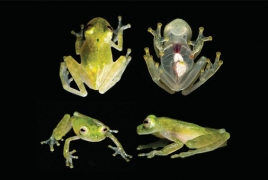
A massive asteroid strike that wiped out the dinosaurs millions of years ago created room for frogs to colonize the Earth, said a study Monday, July 3, that shows how frogs became among the most diverse vertebrates in the world, AFP reports.
As many as 10 types of frogs are believed to have survived the mass extinction some 66 million years ago, which erased three-quarters of life on Earth, said the report in the Proceedings of the National Academy of Sciences.
Of these survivors, just three major kinds of frogs went on to diversify and populate the planet. Some 6,700 known frog species exist today.
Nearly nine in 10 -- 88 percent -- of modern frogs can trace their roots back to these three lineages of hardy ancestors.
"Frogs have been around for well over 200 million years, but this study shows it wasn't until the extinction of the dinosaurs that we had this burst of frog diversity that resulted in the vast majority of frogs we see today," said study co-author David Blackburn, associate curator of amphibians and reptiles at the Florida Museum of Natural History.
"This finding was totally unexpected."
Until now, scientists believed that most modern frog species emerged at a steady pace between 66 million and 150 million years ago.
But the latest research shows frogs burst onto the scene more like an "explosion," as the tiny amphibians swept into habitats left vacant by other creatures.

